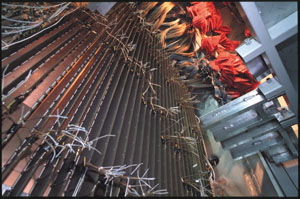
The latest precision measurement of CP violation, matter-antimatter asymmetry, by the big NA48 experiment at CERN underlines the importance of understanding this delicate mechanism, which probably played a major role in shaping the particle scenario that emerged from the Big Bang.
In CP (charge/parity) symmetry the physics of left-handed particles is the same as that of right-handed antiparticles. This idea was suggested after physicists had been shocked in 1956 to discover that the weak interactions of atomic nuclei (beta decay) can differentiate between left and right – weak interactions violate P (parity) symmetry.
In 1964, physicists received another shock when they discovered that the more elaborate CP symmetry is also flawed. Under certain circumstances, nature differentiates between matter and antimatter – what are labelled as particles and as antiparticles is not arbitrary.
The reason for CP violation is still not understood, but whatever it is, it probably helped to shape a universe that was matter antimatter symmetric immediately after the Big Bang into the matter-dominated universe that we know. To our knowledge, antiparticles do not exist naturally and can only be synthesized when high-energy interactions produce particle-antiparticle pairs.
Last year, two major experiments, KTeV at Fermilab and NA48, reported a non-zero value for a vital CP violating parameter that shows that CP is violated directly in the actual decays of the component quarks. CP violation is not simply due to the subtle mixing of neutral particles and antiparticles.
The traditional stage for CP violation is an enigmatic particle – the neutral kaon. It exists in two forms – particle and antiparticle of each other, which are only distinguished by a quantum number – strangeness – that is not conserved in weak interactions. Because of this the two neutral kaons get mixed up.
If CP were good, the neutral kaon would exist in two forms – a short-lived variety decaying relatively easily into two pions, and a long-lived version for which the two-pion decay is not allowed and that has to struggle to produce three pions instead. However, owing to CP violation, this distinction is not total – three parts per thousand of long-lived kaons produce two pions.
To establish whether direct CP violation via the quark decay route contributes to this, physicists must carefully compare two ratios. The first is the rate of long-lived kaons decaying into two neutral pions compared with that into two charged pions, and the second is the equivalent pion-pair decay ratio for short-lived kaons. Making these measurements, involving very similar particle signatures, is extremely difficult.
If these two ratios are not exactly equal, then quark effects do contribute to CP violation. The relevant parameter used by physicists is the difference of this ratio of ratios from unity, divided by a numerical factor. For several years the situation had been unclear, until last year when KTeV reported a parameter of 28 ± 4.1 x 10-4 (thought by theorists to be uncomfortably high), and NA48, using data collected in 1997, which reported 18.5 ± 7.3 x 10-4. The new NA48 number is 14 ± 4.3 x 10-4, including 1998 data, with several times the number of kaon decays seen previously. The resulting new world average result is less surprising to theorists.
Data from 129 days of NA48 running in 1999 are still being analysed, but after this run was complete an accident destroyed the experiment’s carbon fibre beam pipe and damaged some of the detector modules. The apparatus is being repaired to enable more data to be collected and to improve the precision of its final result.







